Organisation Theory Case Study: Analysis of Apple Inc.'s Structure
VerifiedAdded on 2022/12/27
|9
|2641
|3
Case Study
AI Summary
This case study analyzes Apple Inc.'s organisational structure, examining the factors that influence its design, including size, complexity, geographic considerations, environmental turbulence, and technology. It delves into the features of Apple's functional and divisional matrix structures, highlighting its spoke-and-wheel hierarchy, product-based divisions, and weak functional matrix. The study further explores how Apple manages dynamic processes to maintain growth and evolution, referencing Hofstede's cultural dimensions, leadership styles (autocratic, democratic, laissez-faire), and innovation strategies. It emphasizes the relationship between organisational culture, leadership, innovation, and the company's overall success in the technology sector. The study concludes that Apple's approach to leadership and innovation has been critical to its growth.
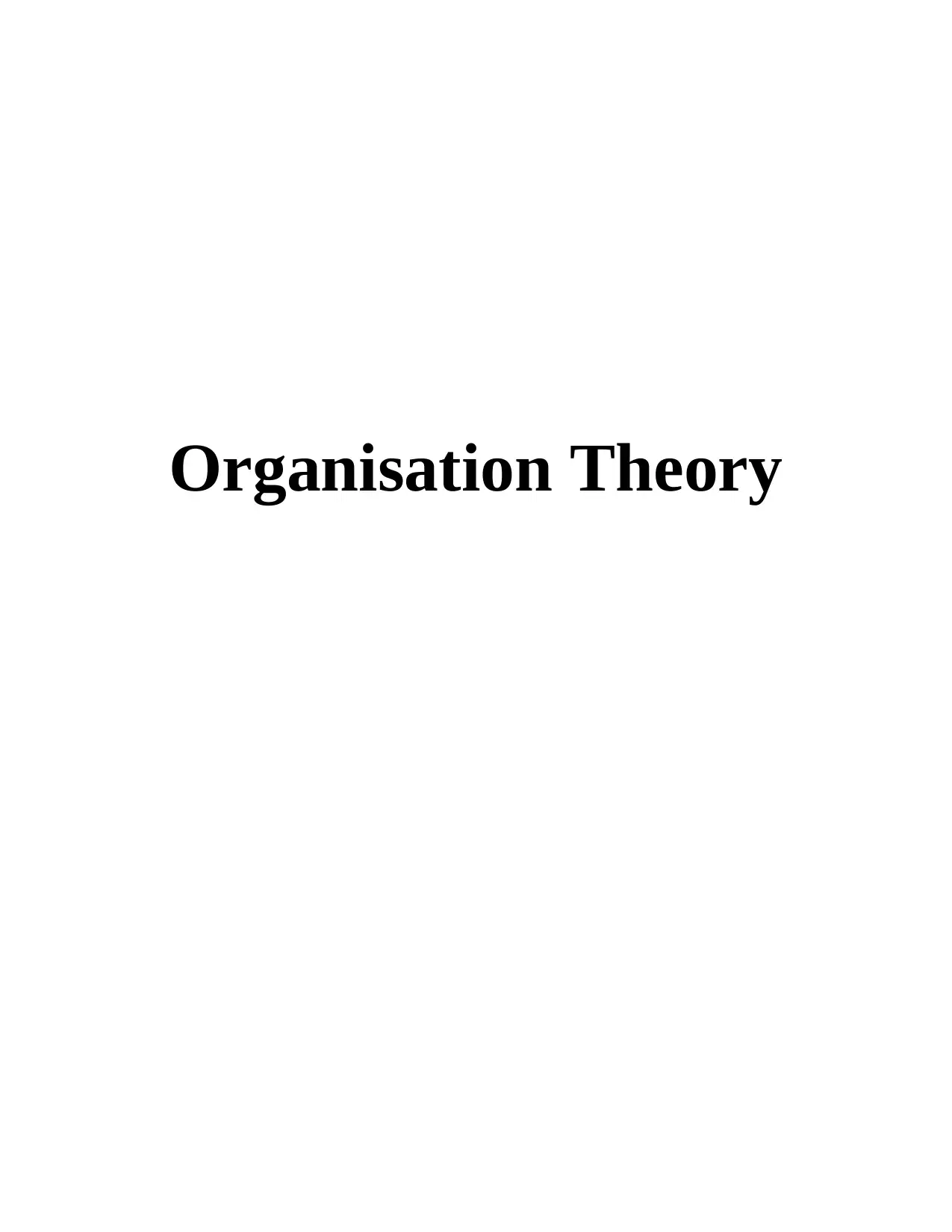
Organisation Theory
Paraphrase This Document
Need a fresh take? Get an instant paraphrase of this document with our AI Paraphraser
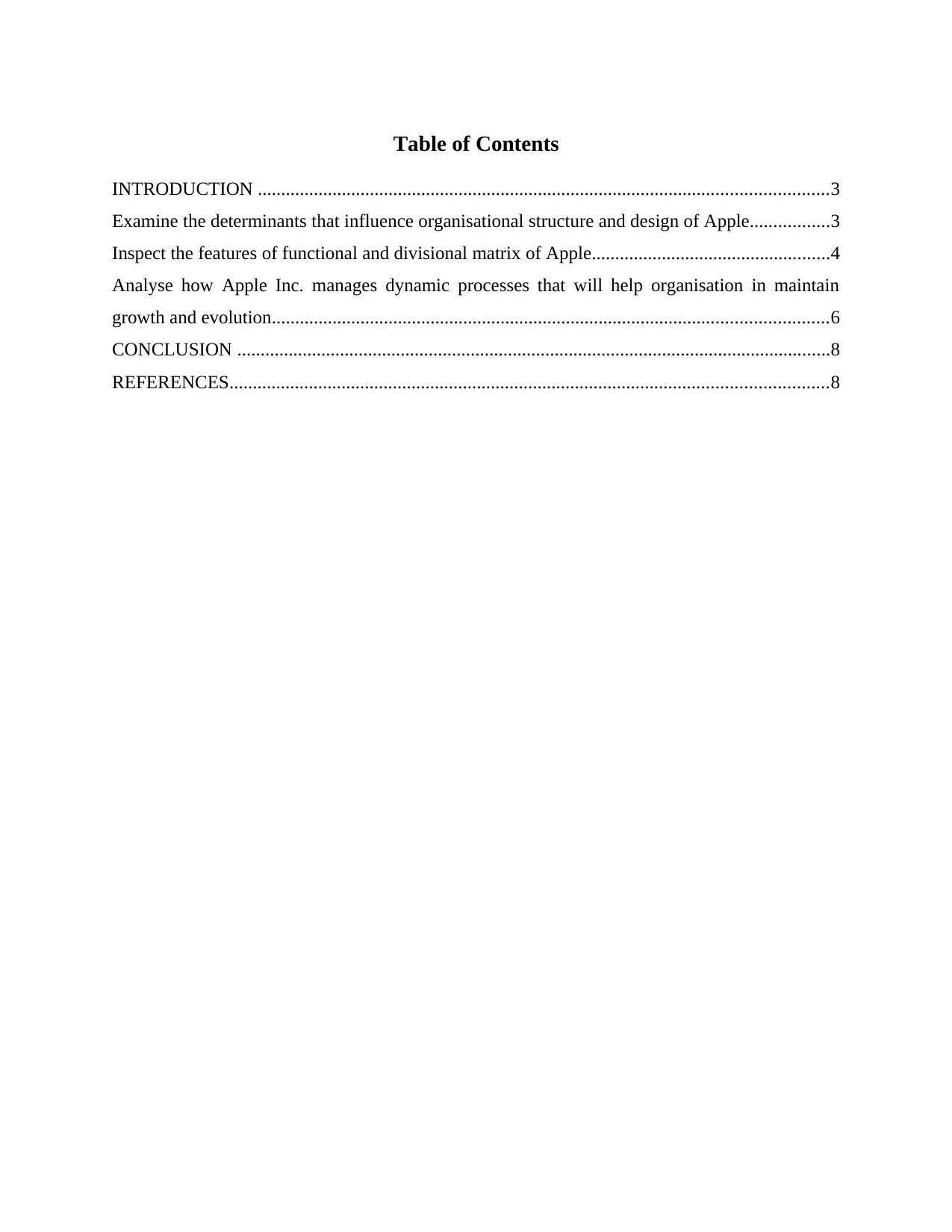
Table of Contents
INTRODUCTION ..........................................................................................................................3
Examine the determinants that influence organisational structure and design of Apple.................3
Inspect the features of functional and divisional matrix of Apple...................................................4
Analyse how Apple Inc. manages dynamic processes that will help organisation in maintain
growth and evolution.......................................................................................................................6
CONCLUSION ...............................................................................................................................8
REFERENCES................................................................................................................................8
INTRODUCTION ..........................................................................................................................3
Examine the determinants that influence organisational structure and design of Apple.................3
Inspect the features of functional and divisional matrix of Apple...................................................4
Analyse how Apple Inc. manages dynamic processes that will help organisation in maintain
growth and evolution.......................................................................................................................6
CONCLUSION ...............................................................................................................................8
REFERENCES................................................................................................................................8

INTRODUCTION
Apple Inc. as per the case study is a USA based multinational company having their businesses
layouts all over the world. It is among the big five companies of information technologies and
very well known for their auto-mobiles product. They have variety of hardware products which
involve iPhone, Mac book, iPad, iPod, and wireless Air Pods.
There are various factors that can affect organising structure and design of any business. They
can be size and complexity of organisation, attitude of personnel, geographic consideration and
many others.
This case will involve all the factors that influence organisational structure of organisation and
dynamic processes that help in organisational growth. Also this case file will cover features of
functional and divisional matrix structures of Apple Inc.
Examine the determinants that influence organisational structure and design
of Apple
Organisational structure and design is very important for business growth and development
because for increasing efficiency and productivity in organisation the organisation should work
smoothly. This is only possible when organisation have proper design and structure. There are
various determinants that affect structuring and design of Apple. All of these factors are listed
and elaborated below:-
Size of organisation:- Size of the organisation is very important factor that affect design
of organisation. Need of structured and organised working environment of organisation is
directly proportional to the size of organisation (Kotni and Karumuri, 2018). Which
means that if the size of organisation is large scale then organisation need to maintain
more structured working environment because there are high chances of errors and
conflict. Apple is a big organisation thus need of proper design of working culture is very
important.
Complexity of organisation:- Complexity of organisation refers to the nature of internal
working of organisation and this inversely proportional to productivity of organisation.
More complex the organisation will be less productivity their employees will have. Apple
is technology based business and pretty complex organisation structure yet they manage
to maintain level of productivity of employees.
Apple Inc. as per the case study is a USA based multinational company having their businesses
layouts all over the world. It is among the big five companies of information technologies and
very well known for their auto-mobiles product. They have variety of hardware products which
involve iPhone, Mac book, iPad, iPod, and wireless Air Pods.
There are various factors that can affect organising structure and design of any business. They
can be size and complexity of organisation, attitude of personnel, geographic consideration and
many others.
This case will involve all the factors that influence organisational structure of organisation and
dynamic processes that help in organisational growth. Also this case file will cover features of
functional and divisional matrix structures of Apple Inc.
Examine the determinants that influence organisational structure and design
of Apple
Organisational structure and design is very important for business growth and development
because for increasing efficiency and productivity in organisation the organisation should work
smoothly. This is only possible when organisation have proper design and structure. There are
various determinants that affect structuring and design of Apple. All of these factors are listed
and elaborated below:-
Size of organisation:- Size of the organisation is very important factor that affect design
of organisation. Need of structured and organised working environment of organisation is
directly proportional to the size of organisation (Kotni and Karumuri, 2018). Which
means that if the size of organisation is large scale then organisation need to maintain
more structured working environment because there are high chances of errors and
conflict. Apple is a big organisation thus need of proper design of working culture is very
important.
Complexity of organisation:- Complexity of organisation refers to the nature of internal
working of organisation and this inversely proportional to productivity of organisation.
More complex the organisation will be less productivity their employees will have. Apple
is technology based business and pretty complex organisation structure yet they manage
to maintain level of productivity of employees.
⊘ This is a preview!⊘
Do you want full access?
Subscribe today to unlock all pages.

Trusted by 1+ million students worldwide
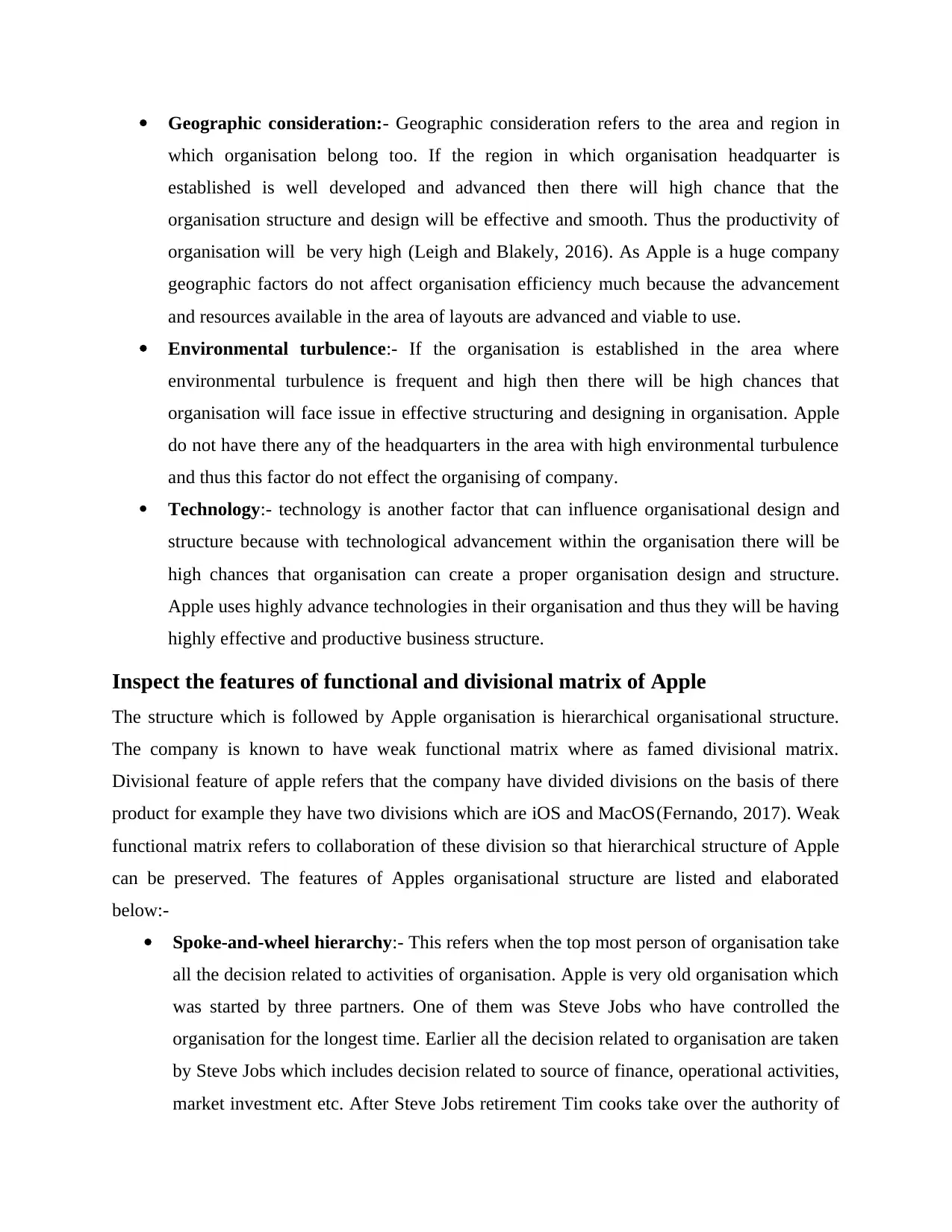
Geographic consideration:- Geographic consideration refers to the area and region in
which organisation belong too. If the region in which organisation headquarter is
established is well developed and advanced then there will high chance that the
organisation structure and design will be effective and smooth. Thus the productivity of
organisation will be very high (Leigh and Blakely, 2016). As Apple is a huge company
geographic factors do not affect organisation efficiency much because the advancement
and resources available in the area of layouts are advanced and viable to use.
Environmental turbulence:- If the organisation is established in the area where
environmental turbulence is frequent and high then there will be high chances that
organisation will face issue in effective structuring and designing in organisation. Apple
do not have there any of the headquarters in the area with high environmental turbulence
and thus this factor do not effect the organising of company.
Technology:- technology is another factor that can influence organisational design and
structure because with technological advancement within the organisation there will be
high chances that organisation can create a proper organisation design and structure.
Apple uses highly advance technologies in their organisation and thus they will be having
highly effective and productive business structure.
Inspect the features of functional and divisional matrix of Apple
The structure which is followed by Apple organisation is hierarchical organisational structure.
The company is known to have weak functional matrix where as famed divisional matrix.
Divisional feature of apple refers that the company have divided divisions on the basis of there
product for example they have two divisions which are iOS and MacOS(Fernando, 2017). Weak
functional matrix refers to collaboration of these division so that hierarchical structure of Apple
can be preserved. The features of Apples organisational structure are listed and elaborated
below:-
Spoke-and-wheel hierarchy:- This refers when the top most person of organisation take
all the decision related to activities of organisation. Apple is very old organisation which
was started by three partners. One of them was Steve Jobs who have controlled the
organisation for the longest time. Earlier all the decision related to organisation are taken
by Steve Jobs which includes decision related to source of finance, operational activities,
market investment etc. After Steve Jobs retirement Tim cooks take over the authority of
which organisation belong too. If the region in which organisation headquarter is
established is well developed and advanced then there will high chance that the
organisation structure and design will be effective and smooth. Thus the productivity of
organisation will be very high (Leigh and Blakely, 2016). As Apple is a huge company
geographic factors do not affect organisation efficiency much because the advancement
and resources available in the area of layouts are advanced and viable to use.
Environmental turbulence:- If the organisation is established in the area where
environmental turbulence is frequent and high then there will be high chances that
organisation will face issue in effective structuring and designing in organisation. Apple
do not have there any of the headquarters in the area with high environmental turbulence
and thus this factor do not effect the organising of company.
Technology:- technology is another factor that can influence organisational design and
structure because with technological advancement within the organisation there will be
high chances that organisation can create a proper organisation design and structure.
Apple uses highly advance technologies in their organisation and thus they will be having
highly effective and productive business structure.
Inspect the features of functional and divisional matrix of Apple
The structure which is followed by Apple organisation is hierarchical organisational structure.
The company is known to have weak functional matrix where as famed divisional matrix.
Divisional feature of apple refers that the company have divided divisions on the basis of there
product for example they have two divisions which are iOS and MacOS(Fernando, 2017). Weak
functional matrix refers to collaboration of these division so that hierarchical structure of Apple
can be preserved. The features of Apples organisational structure are listed and elaborated
below:-
Spoke-and-wheel hierarchy:- This refers when the top most person of organisation take
all the decision related to activities of organisation. Apple is very old organisation which
was started by three partners. One of them was Steve Jobs who have controlled the
organisation for the longest time. Earlier all the decision related to organisation are taken
by Steve Jobs which includes decision related to source of finance, operational activities,
market investment etc. After Steve Jobs retirement Tim cooks take over the authority of
Paraphrase This Document
Need a fresh take? Get an instant paraphrase of this document with our AI Paraphraser
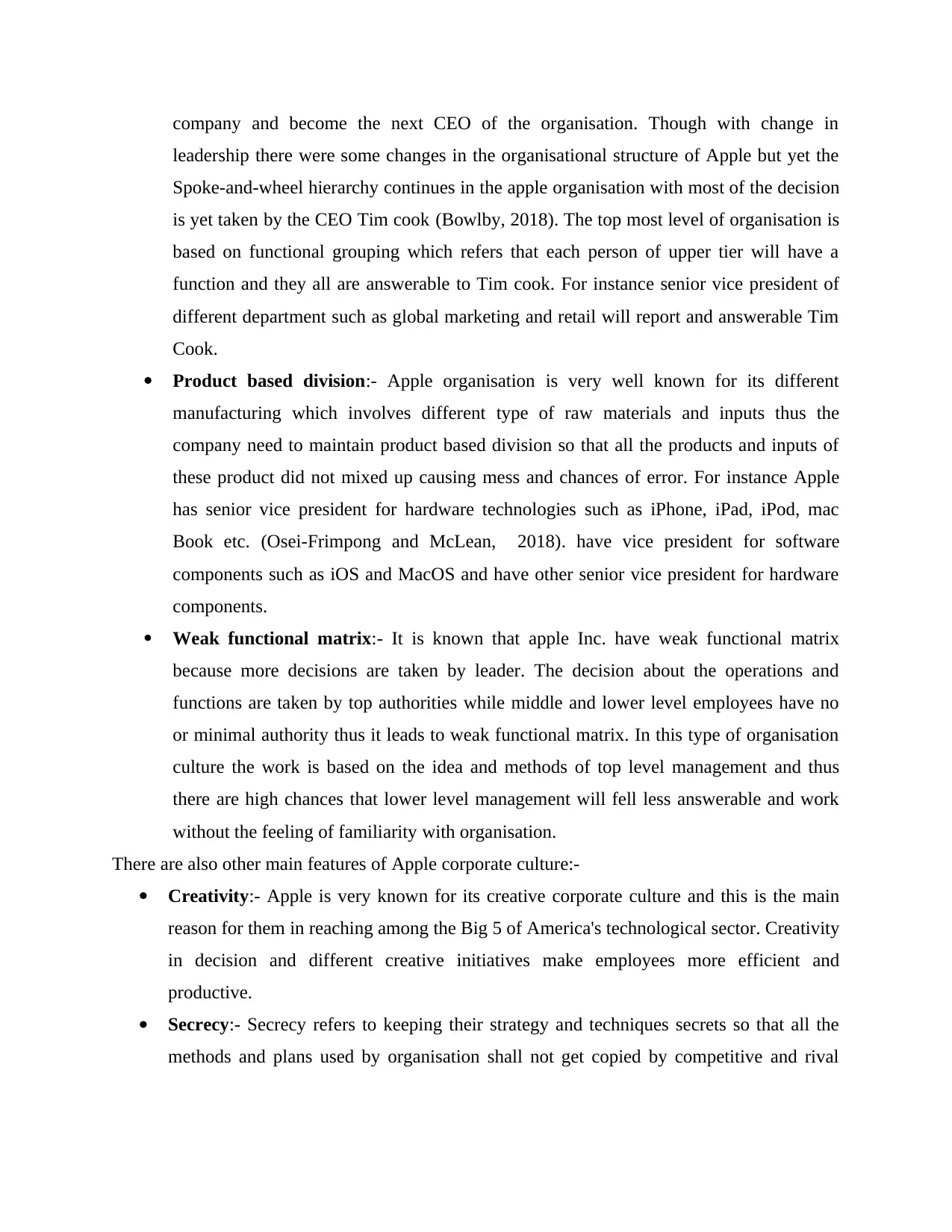
company and become the next CEO of the organisation. Though with change in
leadership there were some changes in the organisational structure of Apple but yet the
Spoke-and-wheel hierarchy continues in the apple organisation with most of the decision
is yet taken by the CEO Tim cook (Bowlby, 2018). The top most level of organisation is
based on functional grouping which refers that each person of upper tier will have a
function and they all are answerable to Tim cook. For instance senior vice president of
different department such as global marketing and retail will report and answerable Tim
Cook.
Product based division:- Apple organisation is very well known for its different
manufacturing which involves different type of raw materials and inputs thus the
company need to maintain product based division so that all the products and inputs of
these product did not mixed up causing mess and chances of error. For instance Apple
has senior vice president for hardware technologies such as iPhone, iPad, iPod, mac
Book etc. (Osei-Frimpong and McLean, 2018). have vice president for software
components such as iOS and MacOS and have other senior vice president for hardware
components.
Weak functional matrix:- It is known that apple Inc. have weak functional matrix
because more decisions are taken by leader. The decision about the operations and
functions are taken by top authorities while middle and lower level employees have no
or minimal authority thus it leads to weak functional matrix. In this type of organisation
culture the work is based on the idea and methods of top level management and thus
there are high chances that lower level management will fell less answerable and work
without the feeling of familiarity with organisation.
There are also other main features of Apple corporate culture:-
Creativity:- Apple is very known for its creative corporate culture and this is the main
reason for them in reaching among the Big 5 of America's technological sector. Creativity
in decision and different creative initiatives make employees more efficient and
productive.
Secrecy:- Secrecy refers to keeping their strategy and techniques secrets so that all the
methods and plans used by organisation shall not get copied by competitive and rival
leadership there were some changes in the organisational structure of Apple but yet the
Spoke-and-wheel hierarchy continues in the apple organisation with most of the decision
is yet taken by the CEO Tim cook (Bowlby, 2018). The top most level of organisation is
based on functional grouping which refers that each person of upper tier will have a
function and they all are answerable to Tim cook. For instance senior vice president of
different department such as global marketing and retail will report and answerable Tim
Cook.
Product based division:- Apple organisation is very well known for its different
manufacturing which involves different type of raw materials and inputs thus the
company need to maintain product based division so that all the products and inputs of
these product did not mixed up causing mess and chances of error. For instance Apple
has senior vice president for hardware technologies such as iPhone, iPad, iPod, mac
Book etc. (Osei-Frimpong and McLean, 2018). have vice president for software
components such as iOS and MacOS and have other senior vice president for hardware
components.
Weak functional matrix:- It is known that apple Inc. have weak functional matrix
because more decisions are taken by leader. The decision about the operations and
functions are taken by top authorities while middle and lower level employees have no
or minimal authority thus it leads to weak functional matrix. In this type of organisation
culture the work is based on the idea and methods of top level management and thus
there are high chances that lower level management will fell less answerable and work
without the feeling of familiarity with organisation.
There are also other main features of Apple corporate culture:-
Creativity:- Apple is very known for its creative corporate culture and this is the main
reason for them in reaching among the Big 5 of America's technological sector. Creativity
in decision and different creative initiatives make employees more efficient and
productive.
Secrecy:- Secrecy refers to keeping their strategy and techniques secrets so that all the
methods and plans used by organisation shall not get copied by competitive and rival

organisation. Apple corporate structure believe in keeping their methods and techniques
secrets so that they did not get copied.
Innovation:- Innovation refers to implementing new and unused ideas so that different
issues can be addressed effectively and efficiently (Northoff and Huang, 2017). Apple
Inc. promote innovative ideas and suggestions so that organisation can get best result in
market and industry.
Top notch excellence:- Apple Inc. believe in recruiting individuals with top notch of
excellence so that they can put their best foot forward in the organisation and can
promote organisational objectives and goals. By sticking to this policy Apple is able to
capture most of the market share.
Analyse how Apple Inc. manages dynamic processes that will help
organisation in maintain growth and evolution
Relation between culture of organisation and growth and evolution of organisation
To understand the relationship between culture of organisation and growth of organisation here
hofstede cultural dimension is used which contains various aspects on which organisation growth
and culture of organisation is related. All these are listed and elaborated below.
Power distance index:- Power distance index refers to distribution of power in
organisation. In Apple more decisions are taken by CEO Tim Cook yet the leadership
followed is democratic one because employees suggestions are also taken into count if
they are unique and innovative.
Individualism versus collectivism:- Apple Inc. believe in working into teams and
working collectively with coordination. With proper coordination the task burden will be
shared between individuals and thus the task gets completed effectively and efficiently.
Masculinity versus Femininity:- In Apple Inc. leaders believe in giving equal
opportunity and scope to both male and female employees(Gupta Dey and Singh, 2017).
Thus there are no patriarchal thinking in Apple and women can also take initiative and
lead the team and organisation.
Uncertainty avoidance index:- Uncertainty are very basic components of every
organisation working culture and for this purpose Apple Inc. make preplanned strategy so
that they can avoid and eliminate risks of these uncertainty and hence improve chance of
growth and sustainability.
secrets so that they did not get copied.
Innovation:- Innovation refers to implementing new and unused ideas so that different
issues can be addressed effectively and efficiently (Northoff and Huang, 2017). Apple
Inc. promote innovative ideas and suggestions so that organisation can get best result in
market and industry.
Top notch excellence:- Apple Inc. believe in recruiting individuals with top notch of
excellence so that they can put their best foot forward in the organisation and can
promote organisational objectives and goals. By sticking to this policy Apple is able to
capture most of the market share.
Analyse how Apple Inc. manages dynamic processes that will help
organisation in maintain growth and evolution
Relation between culture of organisation and growth and evolution of organisation
To understand the relationship between culture of organisation and growth of organisation here
hofstede cultural dimension is used which contains various aspects on which organisation growth
and culture of organisation is related. All these are listed and elaborated below.
Power distance index:- Power distance index refers to distribution of power in
organisation. In Apple more decisions are taken by CEO Tim Cook yet the leadership
followed is democratic one because employees suggestions are also taken into count if
they are unique and innovative.
Individualism versus collectivism:- Apple Inc. believe in working into teams and
working collectively with coordination. With proper coordination the task burden will be
shared between individuals and thus the task gets completed effectively and efficiently.
Masculinity versus Femininity:- In Apple Inc. leaders believe in giving equal
opportunity and scope to both male and female employees(Gupta Dey and Singh, 2017).
Thus there are no patriarchal thinking in Apple and women can also take initiative and
lead the team and organisation.
Uncertainty avoidance index:- Uncertainty are very basic components of every
organisation working culture and for this purpose Apple Inc. make preplanned strategy so
that they can avoid and eliminate risks of these uncertainty and hence improve chance of
growth and sustainability.
⊘ This is a preview!⊘
Do you want full access?
Subscribe today to unlock all pages.

Trusted by 1+ million students worldwide
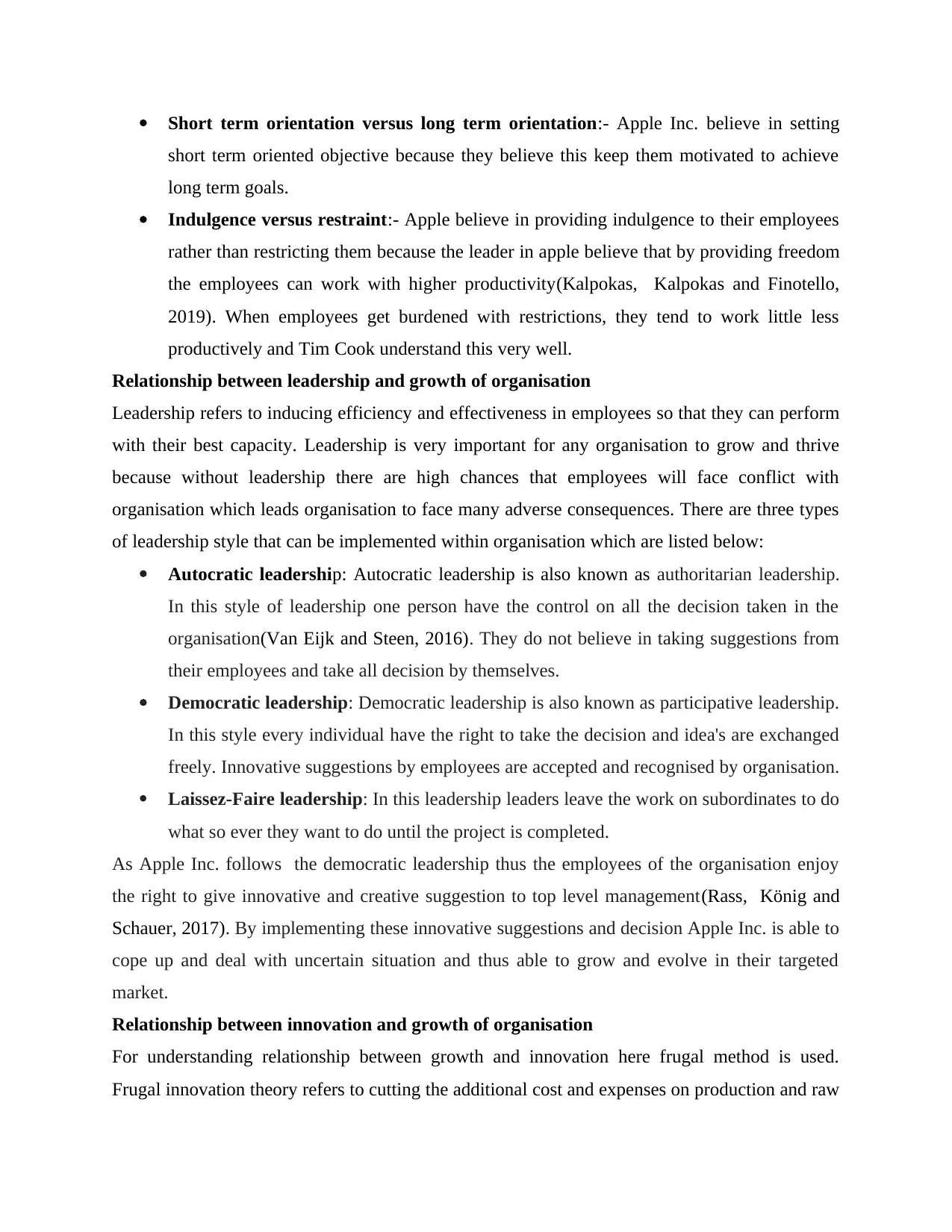
Short term orientation versus long term orientation:- Apple Inc. believe in setting
short term oriented objective because they believe this keep them motivated to achieve
long term goals.
Indulgence versus restraint:- Apple believe in providing indulgence to their employees
rather than restricting them because the leader in apple believe that by providing freedom
the employees can work with higher productivity(Kalpokas, Kalpokas and Finotello,
2019). When employees get burdened with restrictions, they tend to work little less
productively and Tim Cook understand this very well.
Relationship between leadership and growth of organisation
Leadership refers to inducing efficiency and effectiveness in employees so that they can perform
with their best capacity. Leadership is very important for any organisation to grow and thrive
because without leadership there are high chances that employees will face conflict with
organisation which leads organisation to face many adverse consequences. There are three types
of leadership style that can be implemented within organisation which are listed below:
Autocratic leadership: Autocratic leadership is also known as authoritarian leadership.
In this style of leadership one person have the control on all the decision taken in the
organisation(Van Eijk and Steen, 2016). They do not believe in taking suggestions from
their employees and take all decision by themselves.
Democratic leadership: Democratic leadership is also known as participative leadership.
In this style every individual have the right to take the decision and idea's are exchanged
freely. Innovative suggestions by employees are accepted and recognised by organisation.
Laissez-Faire leadership: In this leadership leaders leave the work on subordinates to do
what so ever they want to do until the project is completed.
As Apple Inc. follows the democratic leadership thus the employees of the organisation enjoy
the right to give innovative and creative suggestion to top level management(Rass, König and
Schauer, 2017). By implementing these innovative suggestions and decision Apple Inc. is able to
cope up and deal with uncertain situation and thus able to grow and evolve in their targeted
market.
Relationship between innovation and growth of organisation
For understanding relationship between growth and innovation here frugal method is used.
Frugal innovation theory refers to cutting the additional cost and expenses on production and raw
short term oriented objective because they believe this keep them motivated to achieve
long term goals.
Indulgence versus restraint:- Apple believe in providing indulgence to their employees
rather than restricting them because the leader in apple believe that by providing freedom
the employees can work with higher productivity(Kalpokas, Kalpokas and Finotello,
2019). When employees get burdened with restrictions, they tend to work little less
productively and Tim Cook understand this very well.
Relationship between leadership and growth of organisation
Leadership refers to inducing efficiency and effectiveness in employees so that they can perform
with their best capacity. Leadership is very important for any organisation to grow and thrive
because without leadership there are high chances that employees will face conflict with
organisation which leads organisation to face many adverse consequences. There are three types
of leadership style that can be implemented within organisation which are listed below:
Autocratic leadership: Autocratic leadership is also known as authoritarian leadership.
In this style of leadership one person have the control on all the decision taken in the
organisation(Van Eijk and Steen, 2016). They do not believe in taking suggestions from
their employees and take all decision by themselves.
Democratic leadership: Democratic leadership is also known as participative leadership.
In this style every individual have the right to take the decision and idea's are exchanged
freely. Innovative suggestions by employees are accepted and recognised by organisation.
Laissez-Faire leadership: In this leadership leaders leave the work on subordinates to do
what so ever they want to do until the project is completed.
As Apple Inc. follows the democratic leadership thus the employees of the organisation enjoy
the right to give innovative and creative suggestion to top level management(Rass, König and
Schauer, 2017). By implementing these innovative suggestions and decision Apple Inc. is able to
cope up and deal with uncertain situation and thus able to grow and evolve in their targeted
market.
Relationship between innovation and growth of organisation
For understanding relationship between growth and innovation here frugal method is used.
Frugal innovation theory refers to cutting the additional cost and expenses on production and raw
Paraphrase This Document
Need a fresh take? Get an instant paraphrase of this document with our AI Paraphraser
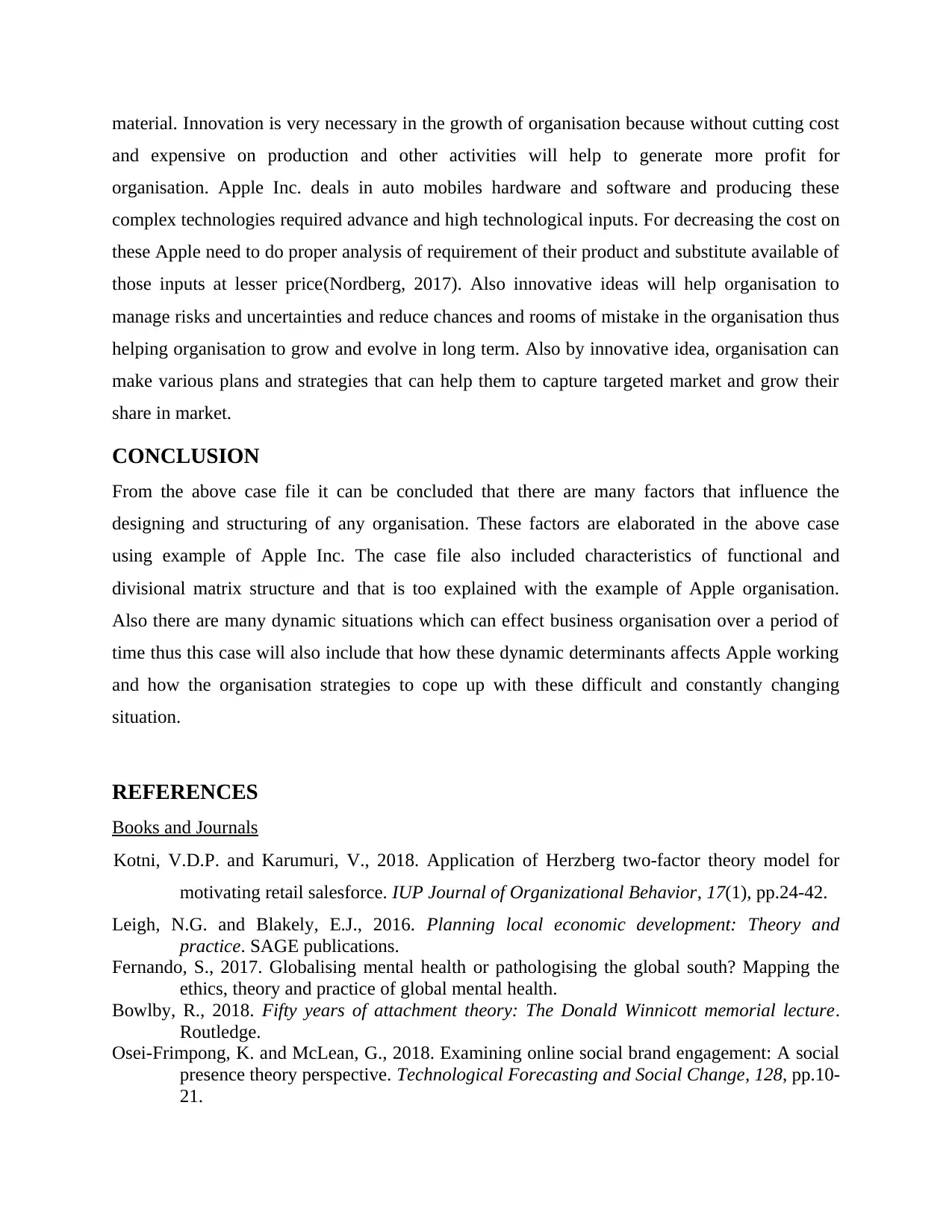
material. Innovation is very necessary in the growth of organisation because without cutting cost
and expensive on production and other activities will help to generate more profit for
organisation. Apple Inc. deals in auto mobiles hardware and software and producing these
complex technologies required advance and high technological inputs. For decreasing the cost on
these Apple need to do proper analysis of requirement of their product and substitute available of
those inputs at lesser price(Nordberg, 2017). Also innovative ideas will help organisation to
manage risks and uncertainties and reduce chances and rooms of mistake in the organisation thus
helping organisation to grow and evolve in long term. Also by innovative idea, organisation can
make various plans and strategies that can help them to capture targeted market and grow their
share in market.
CONCLUSION
From the above case file it can be concluded that there are many factors that influence the
designing and structuring of any organisation. These factors are elaborated in the above case
using example of Apple Inc. The case file also included characteristics of functional and
divisional matrix structure and that is too explained with the example of Apple organisation.
Also there are many dynamic situations which can effect business organisation over a period of
time thus this case will also include that how these dynamic determinants affects Apple working
and how the organisation strategies to cope up with these difficult and constantly changing
situation.
REFERENCES
Books and Journals
Kotni, V.D.P. and Karumuri, V., 2018. Application of Herzberg two-factor theory model for
motivating retail salesforce. IUP Journal of Organizational Behavior, 17(1), pp.24-42.
Leigh, N.G. and Blakely, E.J., 2016. Planning local economic development: Theory and
practice. SAGE publications.
Fernando, S., 2017. Globalising mental health or pathologising the global south? Mapping the
ethics, theory and practice of global mental health.
Bowlby, R., 2018. Fifty years of attachment theory: The Donald Winnicott memorial lecture.
Routledge.
Osei-Frimpong, K. and McLean, G., 2018. Examining online social brand engagement: A social
presence theory perspective. Technological Forecasting and Social Change, 128, pp.10-
21.
and expensive on production and other activities will help to generate more profit for
organisation. Apple Inc. deals in auto mobiles hardware and software and producing these
complex technologies required advance and high technological inputs. For decreasing the cost on
these Apple need to do proper analysis of requirement of their product and substitute available of
those inputs at lesser price(Nordberg, 2017). Also innovative ideas will help organisation to
manage risks and uncertainties and reduce chances and rooms of mistake in the organisation thus
helping organisation to grow and evolve in long term. Also by innovative idea, organisation can
make various plans and strategies that can help them to capture targeted market and grow their
share in market.
CONCLUSION
From the above case file it can be concluded that there are many factors that influence the
designing and structuring of any organisation. These factors are elaborated in the above case
using example of Apple Inc. The case file also included characteristics of functional and
divisional matrix structure and that is too explained with the example of Apple organisation.
Also there are many dynamic situations which can effect business organisation over a period of
time thus this case will also include that how these dynamic determinants affects Apple working
and how the organisation strategies to cope up with these difficult and constantly changing
situation.
REFERENCES
Books and Journals
Kotni, V.D.P. and Karumuri, V., 2018. Application of Herzberg two-factor theory model for
motivating retail salesforce. IUP Journal of Organizational Behavior, 17(1), pp.24-42.
Leigh, N.G. and Blakely, E.J., 2016. Planning local economic development: Theory and
practice. SAGE publications.
Fernando, S., 2017. Globalising mental health or pathologising the global south? Mapping the
ethics, theory and practice of global mental health.
Bowlby, R., 2018. Fifty years of attachment theory: The Donald Winnicott memorial lecture.
Routledge.
Osei-Frimpong, K. and McLean, G., 2018. Examining online social brand engagement: A social
presence theory perspective. Technological Forecasting and Social Change, 128, pp.10-
21.
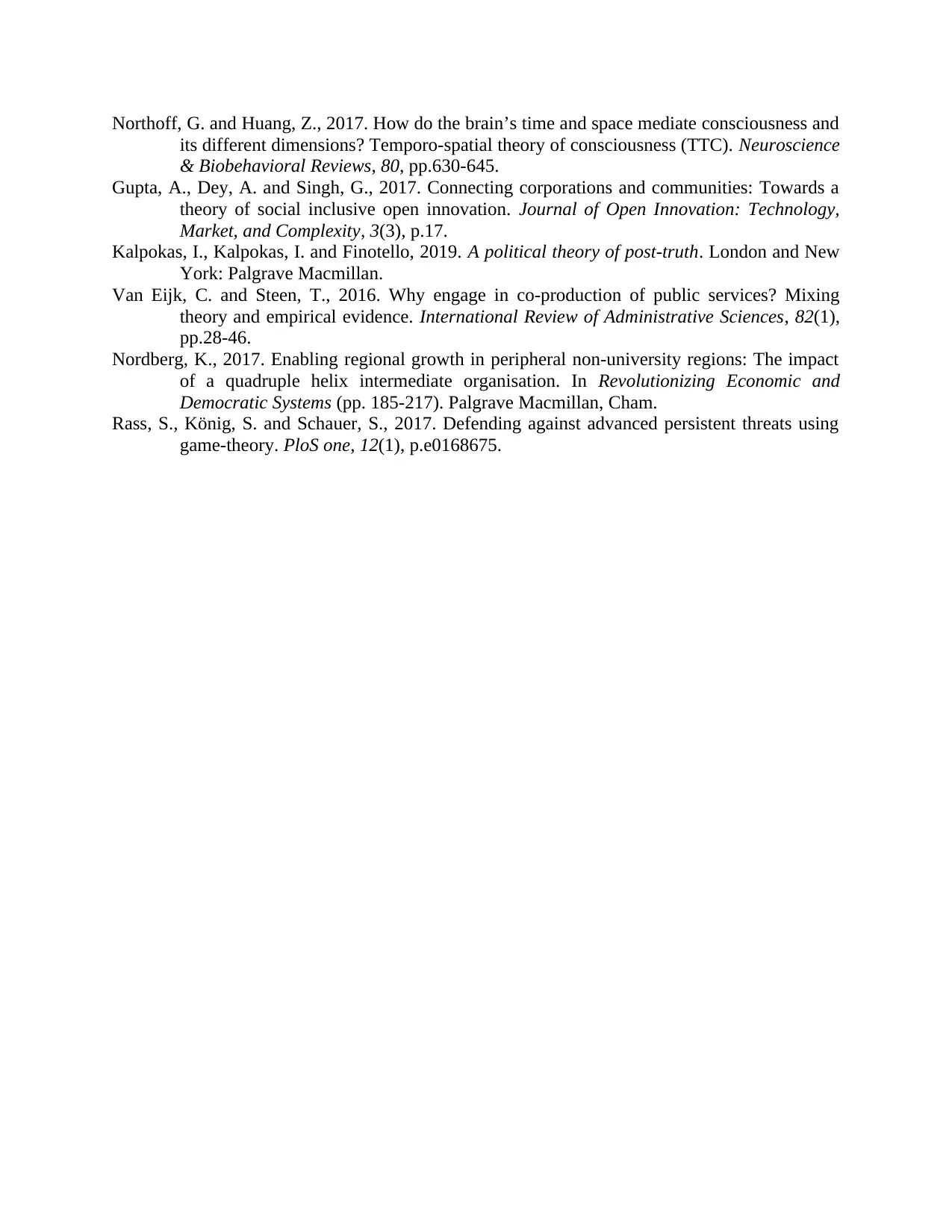
Northoff, G. and Huang, Z., 2017. How do the brain’s time and space mediate consciousness and
its different dimensions? Temporo-spatial theory of consciousness (TTC). Neuroscience
& Biobehavioral Reviews, 80, pp.630-645.
Gupta, A., Dey, A. and Singh, G., 2017. Connecting corporations and communities: Towards a
theory of social inclusive open innovation. Journal of Open Innovation: Technology,
Market, and Complexity, 3(3), p.17.
Kalpokas, I., Kalpokas, I. and Finotello, 2019. A political theory of post-truth. London and New
York: Palgrave Macmillan.
Van Eijk, C. and Steen, T., 2016. Why engage in co-production of public services? Mixing
theory and empirical evidence. International Review of Administrative Sciences, 82(1),
pp.28-46.
Nordberg, K., 2017. Enabling regional growth in peripheral non-university regions: The impact
of a quadruple helix intermediate organisation. In Revolutionizing Economic and
Democratic Systems (pp. 185-217). Palgrave Macmillan, Cham.
Rass, S., König, S. and Schauer, S., 2017. Defending against advanced persistent threats using
game-theory. PloS one, 12(1), p.e0168675.
its different dimensions? Temporo-spatial theory of consciousness (TTC). Neuroscience
& Biobehavioral Reviews, 80, pp.630-645.
Gupta, A., Dey, A. and Singh, G., 2017. Connecting corporations and communities: Towards a
theory of social inclusive open innovation. Journal of Open Innovation: Technology,
Market, and Complexity, 3(3), p.17.
Kalpokas, I., Kalpokas, I. and Finotello, 2019. A political theory of post-truth. London and New
York: Palgrave Macmillan.
Van Eijk, C. and Steen, T., 2016. Why engage in co-production of public services? Mixing
theory and empirical evidence. International Review of Administrative Sciences, 82(1),
pp.28-46.
Nordberg, K., 2017. Enabling regional growth in peripheral non-university regions: The impact
of a quadruple helix intermediate organisation. In Revolutionizing Economic and
Democratic Systems (pp. 185-217). Palgrave Macmillan, Cham.
Rass, S., König, S. and Schauer, S., 2017. Defending against advanced persistent threats using
game-theory. PloS one, 12(1), p.e0168675.
⊘ This is a preview!⊘
Do you want full access?
Subscribe today to unlock all pages.

Trusted by 1+ million students worldwide
1 out of 9
Related Documents
Your All-in-One AI-Powered Toolkit for Academic Success.
+13062052269
info@desklib.com
Available 24*7 on WhatsApp / Email
![[object Object]](/_next/static/media/star-bottom.7253800d.svg)
Unlock your academic potential
Copyright © 2020–2025 A2Z Services. All Rights Reserved. Developed and managed by ZUCOL.




